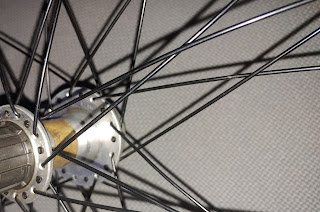DIY Neurocognitive Exam
Since getting bumped in the head, or at least since a couple weeks after getting bumped in the head, so I could remember I was bumped in the head, my general, but not absolute, impression has been that my mental strong points were mostly intact, while my weaknesses, like remembering names, had an accelerated bump to senility. This morning, I tested my processing ability, at home, without any highly trained neurological staff.
Look closely,
Or just trust me,
2 cross drive side,
3 cross large flange disc side!
I used to build wheels, and by used to, I built a couple sets almost a couple decades ago, but most of my lacing came another five to ten years before that. My first instruction, in my late teens, was, "Look at another wheel and copy it." A couple years later, as a shop employee, I was given a few more pointers, and I consider maybe half of those correct. Largely, I am a self taught (mis-taught---wrong tension?) wheel builder, but I seem to do OK, and some for whom I built wheels preferred my productions to any others they'd ridden.
In addition to half-good instruction, working in that shop years ago involved building wheel patterns by what length spokes we had it stock over other more idealized parameters. That and seeing some other asymmetrical lacing helped inspire one of my favorite, and possibly last, builds for a touring bike rear wheel: 3 cross non-drive side opposite one cross, with all the drive side spokes pulling from the outside, allowing for a more even spoke angle despite the dish. If all that made zero or less sense to you, congratulations, you're a well adjusted human rather than a wheel building weeny.
Why this trip down memory lane? The fine and friendly folks at Hampshire Bike Exchange gave me a bike that was given to them on account of a bent rear axle, broken freewheel, and not enough market value to justify the cost of repair. I have an idea for another post on this bequest, but for now, THANK YOU HAMPSHIRE BIKE EXCHANGE!
Bent axle? Sure, yup, I have plenty of salvage hubs from which to pirate a replacement, but that's far to simple a task, and I find freewheel wheels, such as this was, are rather inclined to bend and break axles with their extra long cantilever taking the load. Again, good on you if that last line was met with little understanding, but it's there for any other attending engineers, real or fake.
Rather than just swap the broken part, I knew I had some zero-mileage disc hubs with the appropriate 36 holes, and wonderfully, 8 speed compatible freehubs, so why not reuse the spokes and rim to rebuild something better? The answer, I found along with hubs hub yesterday: the assymetrical non-large non-disc flange of my hub didn't match the hub of the bent-axle donor wheel, so the spoke lengths would be wrong. Correction: the spoke lengths would be wrong for a symmetrical lacing, but not for wheel that tapped my old experience of build-for-what-you-have, not necessarily the norm.
Yes, first memory victory was remembering I knew a work around! The next cognitive test was playing with a spoke calculator to find a lacing that matched that smaller flange, although I suppose an even more exacting test would've been working out the spoke lengths myself with geometry, but I have never done that and am prefer sure I have no intention of changing that fact, although having said it, I do have a hint of curiosity.
Again, again, good on you if you don't feel curious, but now one last test for me: assymetrical lacing requires atypical spoke placement, and yes, I'd worked that out for myself on that touring bike rear wheel build many years ago. I may not remember oh so many names when I'd like them, but yay, I rembered and thought my way to the correct spoke placement on my first try! As much as I enjoy building wheels, I much prefer building them once versus building, then unlacing them to shift the spokes over one hole. That kind of effort savings leaves time in my morning to cross off another blog post!





Comments
Post a Comment